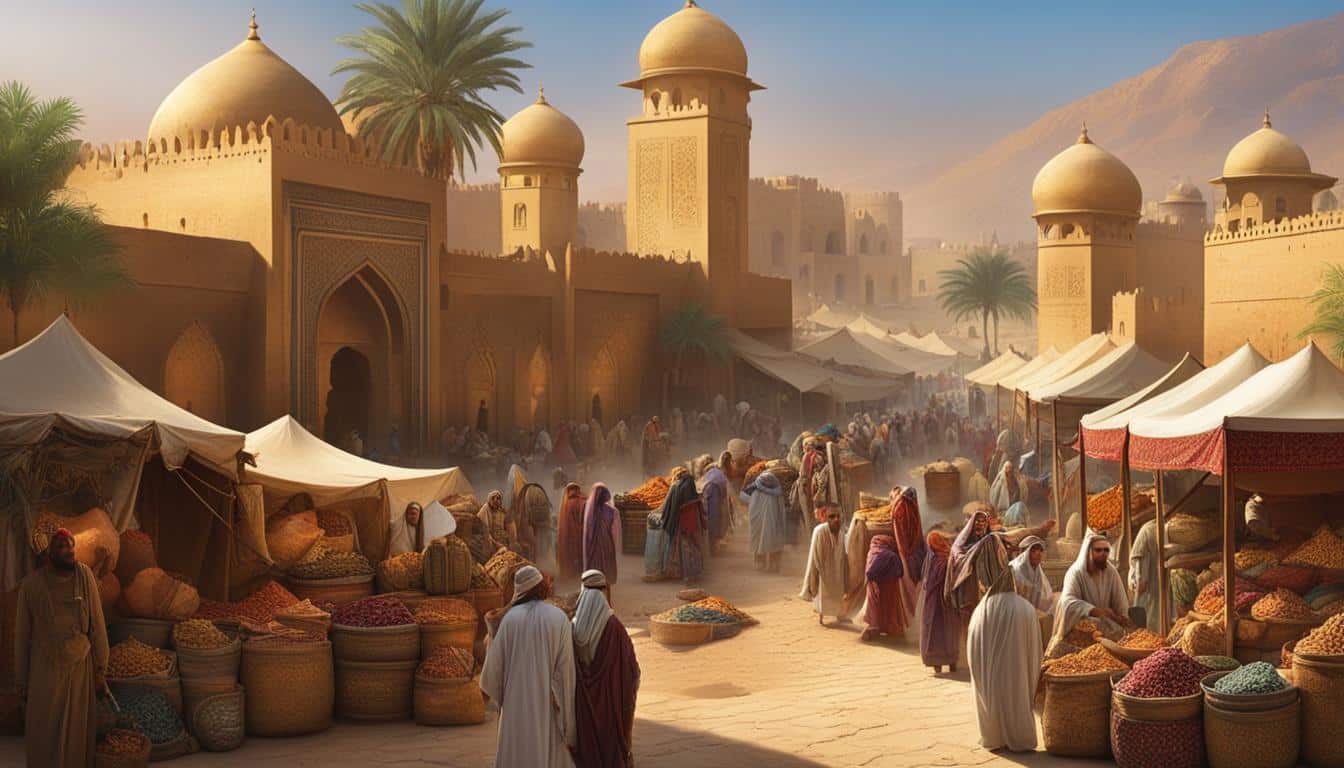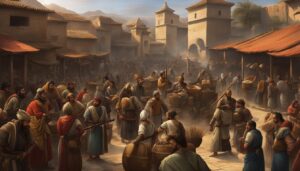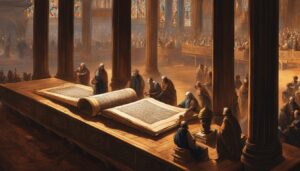
Illuminated manuscripts offer valuable insights into the customs and practices of ancient biblical times. These meticulously crafted manuscripts, adorned with gold and painted decoration, provide a window into the artistic and religious traditions of the past.
Christian scripture, in particular, was extensively illustrated in these manuscripts, while figurative imagery was limited in the Jewish tradition. The use of images in Christian Bibles was encouraged by Pope Gregory the Great as a means of aiding the understanding of illiterate individuals. In the Eastern Church, the use of images was initially banned but later reintroduced and venerated.
Furthermore, the use of precious materials, such as gold leaf, further emphasized the importance and sacredness of the biblical text. The detailed craftsmanship and artistic expression found in these manuscripts showcase the intersection of art and religion, providing a tangible connection to ancient biblical times.
Key Takeaways:
- Ancient customs and practices in the Bible provide valuable insights into the cultural and religious context of biblical times.
- Illuminated manuscripts, adorned with gold and painted decoration, were meticulously crafted and served as visual representations of the sacred text.
- Christian scripture was extensively illustrated, while the use of figurative imagery was limited in the Jewish tradition.
- The inclusion of images in Christian Bibles was justified as a means to aid understanding for the illiterate.
- The use of precious materials, such as gold leaf, further emphasized the importance and sacredness of the biblical text.
Jewish Customs: Unlocking the Depths of the Scriptures
The study of Jewish customs provides valuable insights into the context of the life of Jesus and the practices of the early followers of Yeshua. These customs are not exclusive to Jews but can enrich the understanding of any believer. The Jewish background of the New Testament, including customs such as the redemption of the firstborn and the bar/bat mitzvah, brings a deeper understanding of biblical passages.
The redemption of the firstborn, known as Pidyon ha’Ben, traces back to the biblical account of the Israelites’ deliverance from the tenth plague in Egypt. This custom involves the redemption of firstborn sons through a ritual that includes offering remittance of money. It symbolizes the sanctity of life and the Israelites’ gratitude to God for sparing their firstborn during the Exodus. Through this custom, believers can gain a greater appreciation for God’s deliverance and protection throughout history.
The bar/bat mitzvah ceremony marks the transition of a child to adulthood and responsibility for their own spiritual life. This custom, though not explicitly mentioned in the Hebrew Scriptures, is supported by the concept of an age of accountability and is exemplified by the bar mitzvah of Yeshua himself at the age of twelve. It signifies a young person’s readiness to fully engage with the teachings of the Torah and participate in communal worship. By understanding the significance of this custom, we can better grasp the importance of individual spiritual development and the communal nature of faith.
The Redemption of the Firstborn: A Symbol of God’s Redemption
| Aspect | Description |
|---|---|
| Origin | Traces back to the biblical account of the tenth plague in Egypt |
| Ritual | Involves the redemption of firstborn sons through a monetary offering |
| Symbolism | Represents the sanctity of life and gratitude for God’s protection |
The Bar/Bat Mitzvah: A Milestone of Spiritual Maturity
| Aspect | Description |
|---|---|
| Meaning | Transition of a child to adulthood and responsibility for spiritual life |
| Age | Traditionally celebrated at the age of twelve for boys and thirteen for girls |
| Significance | Indicates readiness to engage with the teachings of the Torah and participate in communal worship |
By exploring and understanding Jewish customs, we can deepen our connection to the Scriptures and gain a more comprehensive understanding of the cultural and historical context in which they were written. These customs provide valuable insights into the faith and practices of ancient Israel, allowing us to unlock the depths of the scriptures and apply their timeless wisdom to our lives today.
Adorning Hebrew Manuscripts: The Intersection of Art and Religion
Throughout history, Hebrew manuscripts have held a special place within Judaism, serving as treasured possessions adorned with captivating decorations and pictures. The inclusion of imagery in these manuscripts raises questions about its compatibility with the biblical prohibition against graven images, but Jewish law permits two-dimensional figurative representations while strictly prohibiting three-dimensional objects. This artistic expression and the beautification of sacred texts are seen as a way to glorify God and enhance spirituality, a concept known as hidur mitsvah.
In the medieval era, Hebrew illuminated manuscripts were not just religious artifacts but also status symbols and remarkable works of art. Two distinct traditions can be observed in their creation: the influence of Muslim artistic styles in the Near East and the affinity with Christian European illumination. Jewish scribes often entrusted the decorative elements to professional illuminators, who added their expertise to bring out the illuminated beauty of the manuscripts. It is worth noting that the beauty of the Hebrew script itself played a significant role in the overall ornamentation of these manuscripts.
One intriguing feature found in these manuscripts is the incorporation of micrography, a technique where minuscule lettering is meticulously woven into abstract designs. This technique not only adds to the visual impact of the manuscripts but also presents a unique way of combining artistry with textual elements. The resulting combination of intricate script and exquisite artwork exemplifies the historical practices and rich customs found in biblical times, transporting us back to a captivating era.
FAQ
What insights can be gained from illuminated manuscripts regarding ancient biblical times?
Illuminated manuscripts offer valuable insights into the customs and practices of ancient biblical times.
How were illuminated manuscripts created?
Illuminated manuscripts were meticulously created by skilled individuals, requiring significant time and resources.
What materials were used in the illumination process?
Illuminated manuscripts incorporated gold or silver and painted decoration, elevating their artistic value.
How extensively were Christian scriptures illustrated in illuminated manuscripts?
Christian scriptures were extensively illustrated in illuminated manuscripts.
Were figurative imagery commonly used in Jewish illuminated manuscripts?
Figurative imagery was limited in the Jewish tradition, with a focus on Christian scripture illustrations.
When did the illumination of Christian Bibles begin?
The illumination of Christian Bibles dates back to the 5th century, with the earliest surviving complete copy being the Codex Alexandrinus.
Why were images included in Christian Bibles?
Pope Gregory the Great justified the inclusion of images in Christian Bibles as a means of facilitating understanding for the illiterate.
Were images initially banned in the Eastern Church?
Images were initially banned in the Eastern Church during the Iconoclast Controversy but were later reintroduced and venerated.
How did the use of precious materials emphasize the importance of illuminated biblical manuscripts?
The use of precious materials, such as gold leaf, in illuminated biblical manuscripts further emphasized the importance of the sacred text.
How can the study of Jewish customs enhance the understanding of biblical passages?
The study of Jewish customs provides valuable insights into the context of the life of Jesus and the practices of the early followers of Yeshua.
What are some examples of Jewish customs mentioned in the New Testament?
Examples of Jewish customs mentioned in the New Testament include the redemption of the firstborn and the bar/bat mitzvah ceremony.
What is the redemption of the firstborn?
The redemption of the firstborn, known as Pidyon ha’Ben, involves the ritualistic redemption of firstborn sons through the offering of remittance money.
What is the significance of the bar/bat mitzvah ceremony?
The bar/bat mitzvah ceremony marks the transition of a child to adulthood and the assumption of responsibility for their own spiritual life.
Were Hebrew manuscripts adorned with decorations and pictures?
Hebrew manuscripts have been cherished possessions in Judaism throughout history and were adorned with decorations and pictures.
How does the inclusion of imagery in Hebrew manuscripts align with the biblical prohibition against graven images?
Jewish law permits two-dimensional figurative representations while strictly prohibiting three-dimensional objects.
How did Jewish scribes incorporate decorative elements into Hebrew illuminated manuscripts?
Jewish scribes often entrusted the decorative elements to professional illuminators, while also emphasizing the beauty of the Hebrew script itself.
What is the significance of micrography in Hebrew illuminated manuscripts?
The incorporation of micrography, the weaving of minuscule lettering into abstract designs, adds to the visual impact of these manuscripts.








